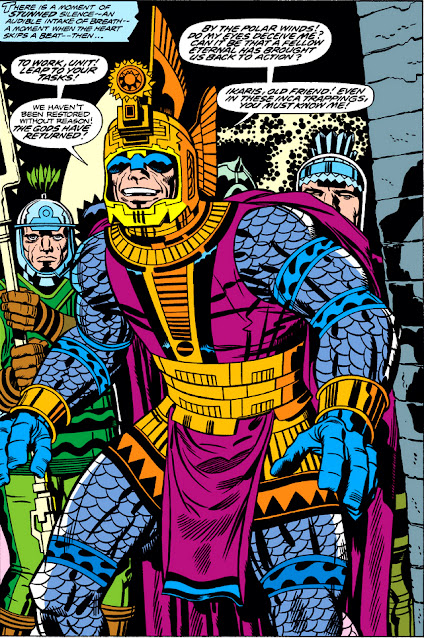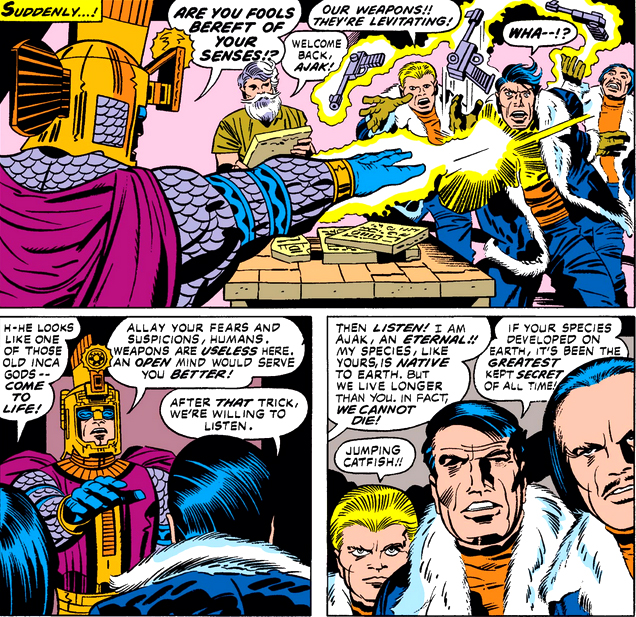In 1979, when the mighty Thor made the decision to pursue and deal with the looming threat of the "space gods" known as the Celestials, his course took him to the Andes mountains in South America, and an ancient Inca city hidden inside an impenetrable dome where the fourth host of the Celestials had descended three years earlier to initiate a fifty-year judgment of the human race which might result in our destruction when that judgment was rendered. As we've seen, Thor was forced to alter his mission and instead rescue a plane full of innocent mortals whose passenger jet had been captured by the Celestials for further study; yet in that time he met and learned of Dr. Daniel Damian, an archaeologist who elected to stay in the city at the time the dome was sealed--while also trapped with Dr. Damian were the discorporated atoms of three S.H.I.E.L.D. agents who had been sent to the area to investigate, but encountered much, much more than they could have conceived.
To learn their fate, as well as the circumstances involving Dr. Damian's choice to spend the rest of his life in this "city of space gods," we circle back to get a look at these events through the eyes of the man who put them in motion: artist/writer Jack Kirby, who was producing a notable new series at Marvel known as The Eternals, a race of beings who came about when the first Celestial host arrived on Earth millennia ago and began experimenting with what was then the highest form of life on the planet--the ape--to produce, in time, three entirely different species, one of which was an advanced form of human which would live separate from their more primitive brethren and be immune to death (ergo, the Eternals).
One of their number, Ikaris, is present when Dr. Damain and his daughter Margo arrive to study the Inca city and artifacts which, incredibly, seem to represent beings not of Earth. And there is one other Eternal left to be discovered in this city--a fellow Eternal left in a crypt to await the day when the fourth Celestial host would arrive and deposit those who would decide the fate of a world.
Ajak, as we discovered previously, also became known to Thor when the Thunder God met the Eternals just prior to the arrival of the space gods' third host--and the two would renew their association one-thousand years later during Thor's time in the city where the Celestials had congregated to undertake their judgment of our world. But now, we return three years before that point, when Kirby has begun to share these inspired concepts for the first time--where Ajak and others emerge from the crypt where their atoms were stored by the Celestials pending their return to Earth, and we piece together the events which would eventually lead to Thor's involvement. Considering the stakes and beings involved, it's become all too clear that this would be a matter to eventually be settled among gods.
Yet there is little time for Dr. Damian and his daughter to take in and attempt to understand what they are seeing--because with the Celestials' arrival, there is now a deadline in effect for the immediate area in which they will conduct their activities, one which mandates a decision to be made from those who must choose whether to live out their lives in the presence of gigantic beings to whom they are mere ants. We're left to assume that Ajak's "ground crew" considers it an honor to do so, regardless of the personal cost; but while Dr. Damian has no real sacrifice to make in light of his age and his desire to study the archaeological find of a lifetime, his daughter is faced with an impossible choice which cannot be adequately weighed in the time allowed.
While I've often been critical of Kirby's style of writing, his handling of this entire scene has been splendid from start to finish, taking appropriate advantage of the tension of the moment--and, in the process, establishing the Celestials as a compelling presence in the developing story of the Eternals.
But what of the fate of our hapless SHIELD agents? It turns out they were following up on a Pentagon report regarding a strange structure in the Andes mountains large enough to be sighted from the air. And given the fact that the structure is transparent, stranger still was one of the sights inside, though "astonishing" and "shocking" are words which might also come to mind.
Fittingly, it has been Gammenon, the "gathering" Celestial, which had dealt with the SHIELD agents who by now have been reported to be M.I.A.--but it will fall to Dr. Damian, who has been busily documenting his findings, to help them adjust to the situation at hand. That is, once they've been recovered from "storage."
Having heard enough, to say that these men have become spurred to take the initiative is probably a fair assumption to make considering their next move. Given their mission, they likely wish to avoid the feeling of being helplessly trapped here, and going into "action" has been their tried and true means by which they've extricated themselves from dicey situations in the past. Had Nick Fury or their other superiors been present, they might have been ordered to continue gathering information until the time was right to attempt escape--but knowing they can't expect backup, and the importance of reporting back with what they've learned, they decide on a course of action that will hopefully produce enough chaos and distraction to allow them to beat a path out of the domed enclosure (assuming they can breach it).
It would be left to SHIELD/CIA agent (even writer Roy Thomas couldn't decide which) "Mr. Johnson" to later discover what became of his missing friends, who were still in storage by the time of Thor's arrival in the city. Johnson, unfortunately, also sought to escape the city through violent means, forcing Thor to deal with him--and when the Thunder God departs with the plane and its passengers (including Johnson), he decides to leave the other three agents behind since even 20th century science wouldn't have had the means to restore them. (Though SHIELD might have had something to say about that.)
And Dr. Damian? His next and final scene in The Eternals occurs in mid-1977, seven issues before Kirby's series comes to a close with Kirby's departure from Marvel for good.
In Thor's 300th issue, where the matter of Arishem's 50-year judgment is finally dealt with, Dr. Damian is nowhere to be found in the story or its aftermath scenes in the following issue (though Ajak is accounted for)--but should he be wandering off-frame somewhere, with the dome around the city breached there is now nothing preventing his reunion with his daughter, particularly since his research has effectively reached its end.
























4 comments:
A lotta people might think this is all a bit corn-ball, but if it is, corn me up.
Kirby's depiction of Arishem was nothing short of cosmic and to me, anyway, a bit terrifying. Even the panel that just shows his head is striking. Just the head. I dunno if a lotta artists can pull that off.
Er, you don't suppose, C.F., that Jack's idea for having the formula for planetary destruction printed on Arishem's thumb mighta came from seeing the Fonz on T.V.? He was a big deal back then.
"They want cool? I'll show these whippersnappers some Kirby Kool! That's how I roll."
M.P.
Ha ha, well, I probably wouldn't read that deeply into Arishem, M.P., since the Fonz's gesture (to my knowledge--I wasn't much of a Happy Days watcher) was used exclusively as a sign of approval. (Though in some countries it's used as we use our middle finger--so it could have pulled double duty for him, given that the middle finger wasn't yet being used in network television at the time.) The thing is, Arishem also used his thumb to judge against a world and make use of that formula inscribed on it--which I don't recall Mr. Winkler's character bothering with, since he was known to be more verbal and imposing when indicating his *ahem* displeasure with someone.
To digress a bit, though, perhaps the real question is: the Celestials need a formula to decimate a world? They sure didn't need one to deal with Odin.
Well Comicsfan, that Odin business is down to Roy Thomas later, and really nothing to do with Kirby. You can't judge the original Eternals series on the basis of what someone else did with the concepts afterwards.
I concur with my colleague the estimable M.P., who is correctamundo about Arishem. That signature blend of the cosmic and the cornball - like giving a fallen silver space angel a surfboard - is what makes Kirby's way out stuff work so well.
Along with the Fonz though, I would suggest the thumb thing also alludes to ancient Rome, and the emperors. Thumb up and Earth lives, but thumb down and...
-sean
An excellent observation about those Roman emperors, sean. :) (For what it's worth, at least the Celestials are a bit more deliberative in their judgment!)
Post a Comment